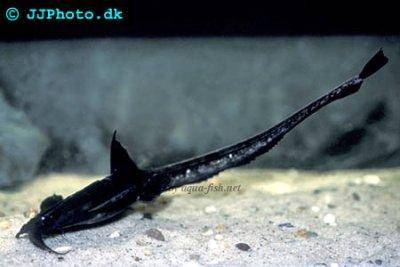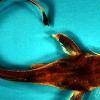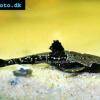Banded banjo - Platystacus cotylephorus
Scientific name: Platystacus cotylephorus
Common name: Banded banjo
Family: Aspredinidae
Usual size in fish tanks: 25 - 32 cm (9.84 - 12.6 inch)
014
Recommended pH range: 6.7 - 8.2
Recommended water hardness: 12 - 24°N (214.29 - 428.57ppm)
0°C 32°F30°C 86°F
Recommended temperature range: 22 - 25 °C (71.6 - 77°F)
The way how these fish reproduce: Spawning
Where the species comes from: South America
Temperament to its own species: peaceful
Temperament toward other fish species: peaceful
Usual place in the tank: Bottom levels
General Information
The Banded Banjo Catfish (Platystacus cotylephorus) is a large, peaceful aspredinid from the coastal rivers and estuaries of northern South America (roughly Venezuela to northern Brazil). It inhabits soft, turbid bottoms near river mouths and often ventures into low-salinity brackish zones. A cryptic, nocturnal burrower, it spends much of the day half-buried in sand or leaf litter and emerges at night to scavenge. Adults commonly reach 25–32 cm in aquaria, so plan for ample floor space and a soft substrate.
Food and Feeding
A slow, methodical feeder that prefers food on or just above the substrate. Offer a staple of quality sinking pellets/tablets, supplemented with meaty fare for condition: live or frozen bloodworms, mosquito larvae, brine shrimp, daphnia, mysis, and chopped earthworms. Feed after lights-out or under dim light so it isn’t outcompeted by faster tankmates. Remove leftovers promptly to protect water quality.
Sexing
Sexual dimorphism is subtle. Males are often reported with slightly longer dorsal/pectoral fins and may appear marginally more contrasting; females are deeper-bodied when gravid.
Breeding
Unusual brood care: after spawning, the female carries the adhesive eggs on short fleshy stalks (cotylephores) under her belly until hatching. In nature, spawning is believed to occur in brackish water; confirmed captive spawnings are exceptionally rare, though egg-carrying females are occasionally imported and fry have been reared. If attempting, provide very clean water, fine sand, gentle flow, and abundant small live foods for fry once free-swimming.
Lifespan
Typically 8–12 years is reported in aquaria when kept with stable water quality, low stress, and consistent feeding.
Tank Requirements & Water Parameters
- Footprint & substrate: prioritize floor area; use fine sand so the fish can safely bury. Add leaf litter, driftwood and smooth rocks for cover; keep lighting subdued.
- Filtration & flow: strong biofiltration with gentle–moderate current; maintain high oxygenation.
- Water: pH 6.7–8.2; 12–24 °dH; 22–25 °C. This species occurs mainly in brackish zones but migrates into fresh water; it can be maintained in fresh, though slightly alkaline, medium-hard water is preferred. Stability is more important than chasing exact numbers.
- Maintenance: weekly 25–35% water changes; avoid stirring deep anaerobic pockets when cleaning sand.
Compatibility & Tank Mates
Generally very peaceful and reclusive. Combine with calm midwater species that won’t outcompete at feeding time. Avoid fin-nippers and large predators. Note that tiny fish or shrimp may be eaten if they fit in its mouth.
Behaviour & Usual Place in the Tank
Bottom levels (demersal): spends most daylight hours partially buried or tight to the substrate; becomes more active at night, foraging along the bottom. Provide a tight lid—startled individuals may thrash upward.
Care Notes
- Feed at dusk/night to ensure proper intake.
- Use sand, not sharp gravel—protects barbels and belly skin.
- Even though it’s peaceful, its size demands generous space and robust filtration.
Short Description
Banded Banjo Catfish (Platystacus cotylephorus) is a large, nocturnal, sand-burying catfish from estuarine South America. Keep it over fine sand with dim light, provide meaty sinking foods after dark, and expect unusual egg-carrying brood care rather than conventional nesting.
Q&A
- Fresh or brackish? Primarily brackish in the wild, but it migrates into fresh water and can be kept long-term in stable, slightly alkaline fresh conditions; spawning is thought to occur in brackish water.
- Will it uproot plants? It doesn’t dig like some cichlids, but frequent burying can disturb shallow-rooted plants; use hardscape and epiphytes on wood/rock.
- Daytime visibility? Low—expect a cryptic fish that hides by day and feeds at night. Red/blue moonlighting can help observation.
Pictures
Bought by aqua-fish.net from jjphoto.dk.





 Banjo
Banjo  Banjo
Banjo